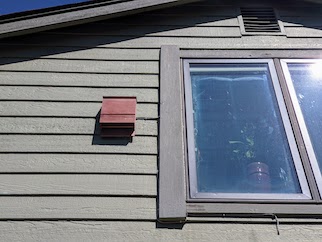The Buzbee Bat House
Temperature Plot
The Box

This is the off-the-shelf batbox I picked up from Amazon. It's smaller than
recommended
, but I thought I'd give it a
try becuase I don't think I've ever gotten more than one or two bats living up in the eaves of our house or in my
previous bat house. Bigger boxes will have more temperature stability, but I'll keep an eye on the temperature graph
to see what happens.
The Sensor

This is the sensor I'm using. It wasn't designed for outdoor use so I put it inside one of those little plastic boxes
that SD cards come in. Then I cut out some holes for the wires and drilled a couple of small holes to allow more air to get in
and out for the air-quality sensor. The sensor packs a lot of capability into one little board. Temperature, humidity, air quality, light, sound, etc.
The sensor, by metriful.com, was part of a KickStarter campaign and is no longer available.
The Bat Box Ready for the Sensor

I carved a hold in the back of the bat box to fit the sensor. It looks pretty crude, but I used
the tools I had on-hand. Hopefully the bats won't mind.
The Bat Box With The Sensor

This is the back of the box with the sensor in place. It sticks out a little more than I'd like, but
I couldn't cut the hole much deeper.
The Bat Box Ready for Hanging

In this photo you can see a couple of more additions. I've covered the sensor with some duct-work tape to
protect it from the elements and I've added a connector for the wires so I can connect and
disconnect the box. I decided on using a standard RJ-45 connector so I can use normal Ethernet cabling
to get back into my house for a
Raspberry Pi to take readings. I was somewhat worried about
a long run of cable, but I tested with a 50-foot Ethernet cable and it worked fine. The connector is
bigger than I had hoped, but this part of the bat house will be where the siding on my house has a gap
so it's not as bad as it looks. Before the final hanging, I also covered the connector and cable with
the waterproof tape.
The Bat Box in its final location

This is the final location for the bat box. The window on the right is on the second floor of the Buzbee house. The sensor wiring leaves the bat box on the right
and then follows the edge of the
window frame and then enters the Buzbee house below the window into the
Bat Lab where the Raspberry Pi takes the readings.
Contact

Jim Buzbee
Jim.Buzbee@gmail.com
Jim.Buzbee@gmail.com